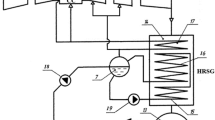Abstract
There has been an ever increasing demand for research into alternative and environmentally friendly fuels since the oil crisis in the 1970s. Nowadays, with increasing energy demands and tightening environmental constraints, the need for research into these alternative fuels is mandatory. The use of microturbines for distributed power generation is already a reality and presents some environmental and operational advantages. However, this kind of thermal machine is designed for operation using hydrocarbons. The difference of the physical–chemical properties between hydrocarbons and alcohols impacts strongly the characteristics of the spray and hence the performance of combustion. In this context, an investigation about the behavior of the atomization process for an atomizer designed for ethanol operation and feasibility is mandatory. This study is divided into two parts: the characterization of the atomizer and spray in a laboratory environment and the assessment for pollutant emissions and combustion efficiency determination. The designed atomizer was machined and the main atomizer and spray characteristics data were acquired and then assembled on a gas generator operating with hydrous ethanol.












Similar content being viewed by others
References
Sun Z, Zhang XY (2012) Advances on distributed generation technology. Energy Proc 17:32–38
Jiayi H, Chuanwen J, Rong X (2008) A review on distributed energy resources and MicroGrid. Renew Sustain Energy Rev 12:2472–2483
Chicco G, Mancarella P (2009) Distributed multi-generation: a comprehensive view. Renew Sustain Energy Rev 13:535–551
Bayod-Rújula AA (2009) Future development of the electricity systems with distributed generation. Energy 34:377–383
Thornton A, Monroy CR (2011) Distributed power generation in the United States. Renew Sustain Energy Rev 15:4809–4817
Aksoy F (2010) The effect of opium poppy oil diesel fuel mixture on engine performance and emissions. Int J Environ Sci Technol 8(1):57–62
Nascimento MAR, Santos EC (2011) Biofuel and gas turbine engines, chap 6. In: Benini E (ed) Advances in gas turbine technology. Intech, pp 115–138
Silva REP, Lacava PT, Carvalho JR (2014) Performance and emissions of a gas turbine engine using ox tallow ethyl-ester blended with kerosene. J Br Soc Mech Sci Eng 36(1):23–28
Lefebvre AH (1989) Atomization and sprays. Taylor and Francis, Washington, DC
Marchione T, Allouis C, Amoresano A, Beretta F (2007) Experimental investigation of a pressure swirl atomizer spray. J Propul Power 23(5):1096–1111
Couto HS, Lacava PT, Bastos-Netto D, Pimenta AP (2009) Experimental evaluation of low pressure-swirl atomizer applied engineering design procedure. J Propuls Power 25(2):358–364
Bayvel L, Orzechowki Z (1993) Liquid atomization. Taylor and Francis, Washington, DC
Kessaev K (2006) Theory and calculation of liquid propellant rocket engine. Moscow Aviation Institute, Moscow
Bazarov V (2004) Design and dynamics of jet and swirl injectors. Paul Zaechan
Allen CAW, Watts KC, Ackman RG (1999) Predicting the surface tension of biodiesel fuels from their fatty acid ester composition. J Am Oil Chem Soc 76(3):317–323
Jones AR (1982) Design optimization of a large pressure-jet atomizer for power plant. In: Proceedings of the 2nd international conference on liquid atomization and spray systems, hemisphere, New York, pp 181–185
Lacava PT, Bastos-Netto D, Pimenta AP (2004) Design procedure and experimental evaluation of pressure-swirl atomizers. In: Proceedings of 24th international congress of the aeronautical sciences, Yokohama
ISO 13320 (2009) Particle size analysis—laser diffraction methods. International Standardization Organization
Turns SR (2000) An introduction to combustion concepts and applications, 2nd edn. McGraw Hill Book Co., USA
Melconian JO, Modak AT (1985) Combustor design, chapter 5. In: Sawyer JW (ed) Sawyer’s gas turbine engineering handbook design. Theory and design, vol 1, 3rd edn. Turbomachinery International Publications, Connecticut, pp 5-1–5-62
Lefebvre H, Ballal DR (2010) Gas turbine combustion: alternative fuels and emissions, 3rd edn. CTC Press, England
Carlisle DR (1955) Communication on the performance of a type of swirl atomizer. In: Radcliffe A (ed) Proceedings of the institution of mechanical engineers, vol 169, no 1, p 101
Risk NK, Lefebvre AH (1985) Internal flow characteristics of simplex swirl atomizers. J Propuls Power 1(3):193–199. doi:10.2514/3.22780
Ballester JM, Dopazo C (1994) Experimental study of the influence of atomization characteristics on the combustion of heavy oil. Combust Sci Technol 103:235–263
Vasiliov AP, Koderaftsov BM, Korbantokov BD, Ablinstsky AM, Polyayov BM, Palvian BY (1993) Principles of theory and calculations of liquid fuel jet, Moscow
Jeng SM, Jog MA, Benjamin MA (1998) Computational and experimental study of liquid sheet emanating from simplex fuel nozzle. AIAA J 36(2):201–207. doi:10.2514/2.7502
Radcliffe A (1960) Fuel injection, high speed aerodynamics and jet propulsion, vol XI, sect D. Princeton University Press, Princeton
Babu KR, Narashiman MV, Narayamaswamy K (1982) Prediction of mean drop size of fuel sprays from spray swirl atomizers. In: Proceedings of the second international conference on liquid atomization and sprays, Madison, pp 99–106
Jasuja AK (1979) Atomization of crude and residual fuel oils. ASME J Eng Power 101(2):250–258
Wang XF, Lefebvre AH (1987) Mean drop sizes from pressure swirl nozzles. J Propuls Power 3(1):11–18
Gosselin P, De Champlain A, Kretschmer D (1999) Prediction of wall heat transfer for a gas turbine combustor. Proc Inst Mech Eng Part A J Power Energy 213:169–180
Bahr DW (1972) Control and reduction of aircraft turbine engine exhaust emissions. In: Cornelius W, Agnew WG (eds) Emissions from continuous combustion systems. Plenum, New York, pp 345–372
Author information
Authors and Affiliations
Corresponding author
Additional information
Technical Editor: Luis Fernando Figueira da Silva.
Rights and permissions
About this article
Cite this article
Silva, R.E.P., dos Santos, L.R., Alves, A. et al. Experimental assessment of a pressure swirl atomizer for ethanol operation on a small gas generator. J Braz. Soc. Mech. Sci. Eng. 39, 1909–1917 (2017). https://doi.org/10.1007/s40430-017-0732-x
Received:
Accepted:
Published:
Issue Date:
DOI: https://doi.org/10.1007/s40430-017-0732-x




